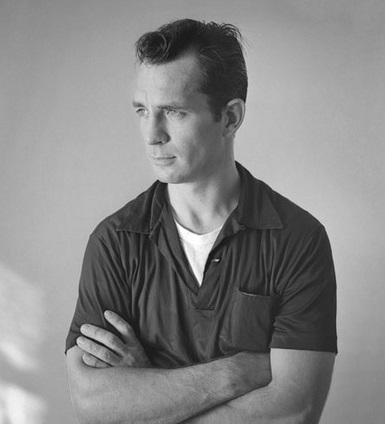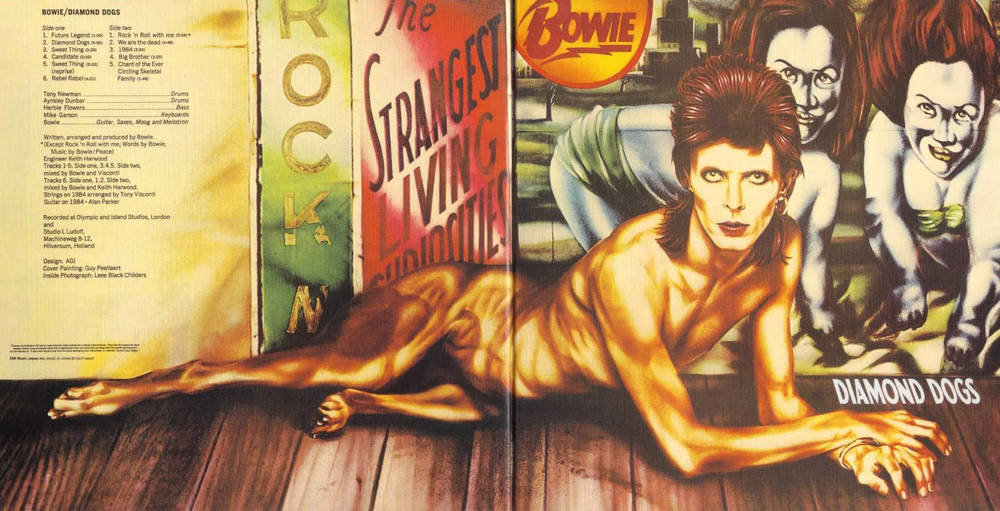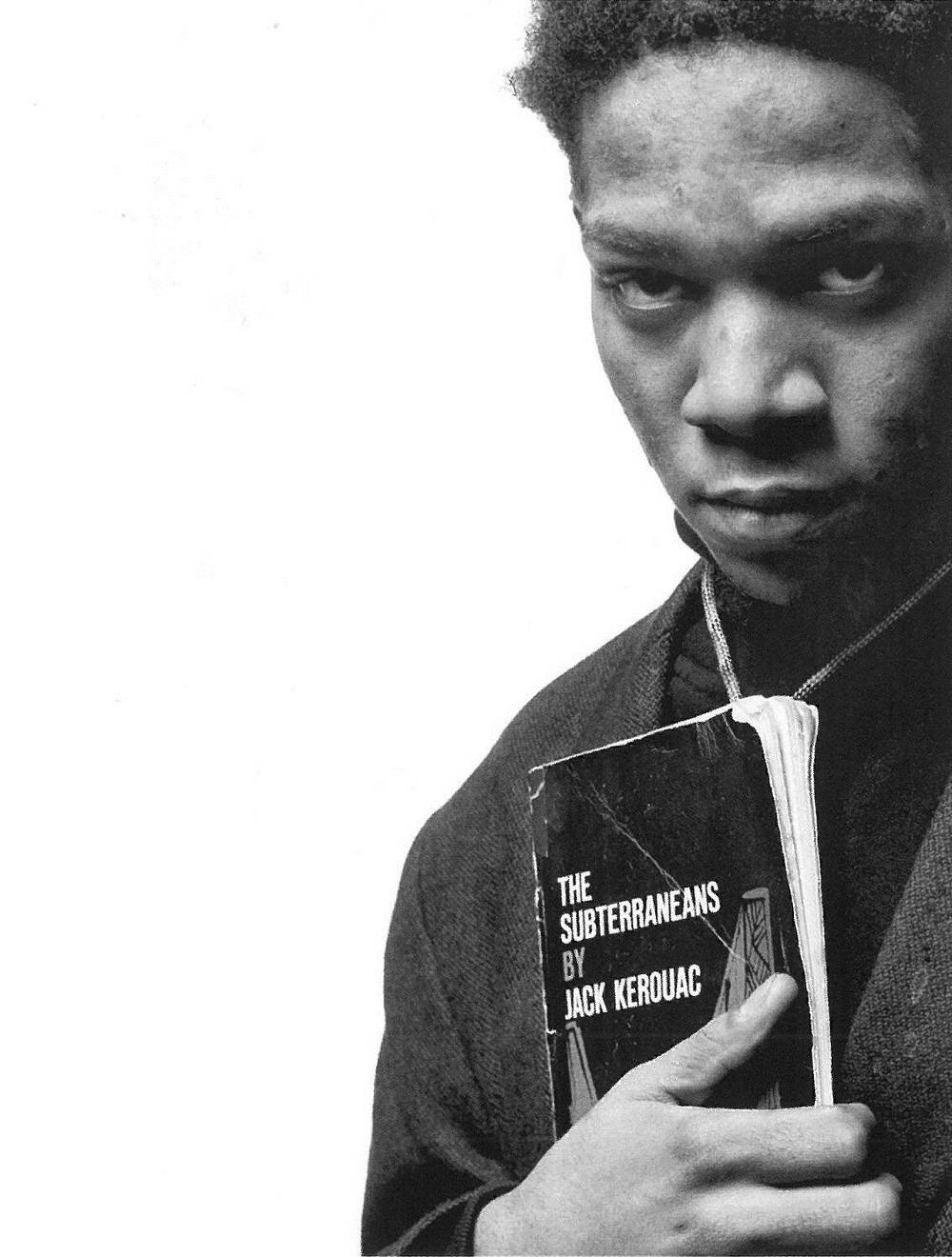TAKE BACK THE KEYS TO THE SHITHOUSE. As an homage to one of his favorite authors, Jean-Michel Basquiat scribbled this bizarre phrase in 1983 on a triptych with the title “Five Fish Species”. The phrase hints at William S. Burroughs’ novel “The Place of Dead Roads”, which was published in the same year, and the work is dedicated to the author. Together with American poet Allen Ginsberg and the writer Jack Kerouac, Burroughs spearheaded the Beat Generation, a community of writers and poets that rebelled against the empty values of American postwar society in the early 1950s.
The self-titled “Beats” embodied the search for a life beyond social norms. Their experimental and radical prose pushed the boundaries of literary conventions, the very expression of social revolt. Kerouac died as early as 1969, but Ginsberg and Burroughs remained important role-models for subsequent generations of authors and intellectuals up until the 1980s. Hence, Burroughs’ windowless apartment in New York’s East Village – the so-called “Bunker” – was a magnet for countless artists and writers, including Jean-Michel Basquiat.
Cryptic-poetic tags
Basquiat’s marked reference to language and text became evident when, at age 17, the artist started leaving cryptic-poetic tags on the walls of New York buildings under the pseudonym SAMO©. From the street to the studio, Basquiat’s text-based approach continued seamlessly. Phrases like JIMMY BEST ON HIS BACK TO THE SUCKERPUNCH OF HIS CHILDHOOD FILES or THE WHOLE LIVERY LINE BOW LIKE THIS WITH THE BIG MONEY ALL CRUSHED TO THESE FEET are testament to his keen sense of sound and rhythm. At the same time, Beat literature – far beyond personal references – had a crucial influence on Jean-Michel Basquiat’s work.

Jean-Michel Basquiat, Five Fish Species, 1983 (c) VG-Bild Kunst & The Estate of Jean-Michel Basquiat by SIAE 2016, Image via: collectibledry.com

William S. Burroughs and Jean-Michel Basquiat, 1986, Image via: benwaylab.com
For the Beat writers, the most important thing was expressing the lives they were living in a way that was as unfiltered as possible. Their semi-autobiographical, semi-fictional texts were steeped in an urgency to make their own voices heard. Inspired by the music of Bebop, spontaneity, improvisation, speed and individuality were primary elements for them – just as they were for Basquiat. Hence Jack Kerouac advised budding writers to ignore any conventions in their writing and to draw creativity from their own experiences without holding back: “No fear or shame in the dignity of yr experience, language & knowledge (...) Composing wild, undisciplined, pure, coming in from under, crazier the better.”
No fear or shame in the dignity of yr experience, language & knowledge (...) Composing wild, undisciplined, pure, coming in from under, crazier the better.
In works like “On The Road” (1957), Kerouac described his world in the form of pages-long streams of consciousness, with sentences broken up merely by dashes, which he fittingly compared with a Jazz saxophonist’s intakes of breath. We find this same feverishness in Basquiat’s works, which are covered with words, symbols and images from top to bottom and thus exude a tremendous energy. In his work, Basquiat drew inspiration from his immediate environment: Constantly surrounded by source materials on which he could toil, the elements come together associatively and spontaneously in the painting process.
Cut-ups on the canvas
The comparison of Basquiat’s work with the cut-up technique made popular by Burroughs is obvious. With the cut-up approach, an existing text is broken down into short sections and is then rearranged according to the principle of chance. Burroughs saw the cut-up as a kind of literary collage, a hybrid, which was both text and image at the same time. Even musical greats like David Bowie drew inspiration from the technique in songs like “Sweet Thing” (1974). Basquiat, on the other hand, had no need for scissors; his cut-up came together directly on the canvas.


As if he had cut up and rearranged the world around him, Basquiat combined text fragments, words, symbols and images from various different sources. As Burroughs himself postulated, the originality of these set pieces was irrelevant – it was all about the surprising moments in which things that previously did not belong together produced an unintended but meaningful sense. Here, Basquiat made equal use of history books, the Bible and even Cornflakes packaging he had to hand; he broke down any hierarchy among his sources and brought them together in new, surprising constellations.
Fragmented Identities
Shortly before his death, Basquiat had himself photographed ostentatiously holding Kerouac’s “The Subterraneans” (1958). He clutches the book to his chest, so the portrait hints at how much he identified with the literature of the Beats. In their writing, art and life are always closely intertwined: Inherent in their works are the vision of a self-determined life and the celebration of their status as social outsiders, which they favor over adaptation to society. Autobiographical scenes merge with fictional supplementation; real protagonists become role-models for characters in novels.

For Jean-Michel Basquiat too, the negotiation of his own identity and biography was an ongoing motivation: Sometimes he combined his self-portrait with the stories of great black Jazz musicians or sporting heroes, at other times he would play around with his ambiguous alter-ego figure “Aaron”. Basquiat identified with the Beats’ ambivalent approach to their own identity, but also their uncompromising nature and their existentialism – divided by a generation, but joined in spirit.
Digitorial on the exhibition
The free Digitorial on the exhibition BASQUIAT. BOOM FOR REAL provides you with background information about the key exhibition aspects.
For desktop, tablet and mobile
